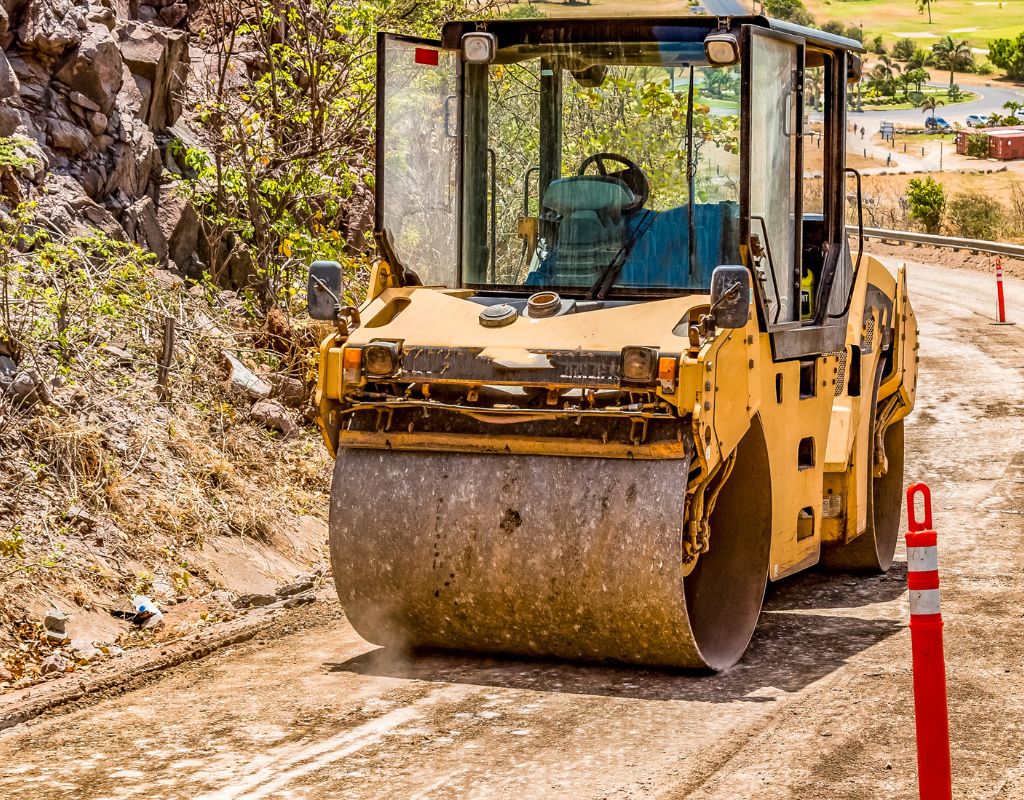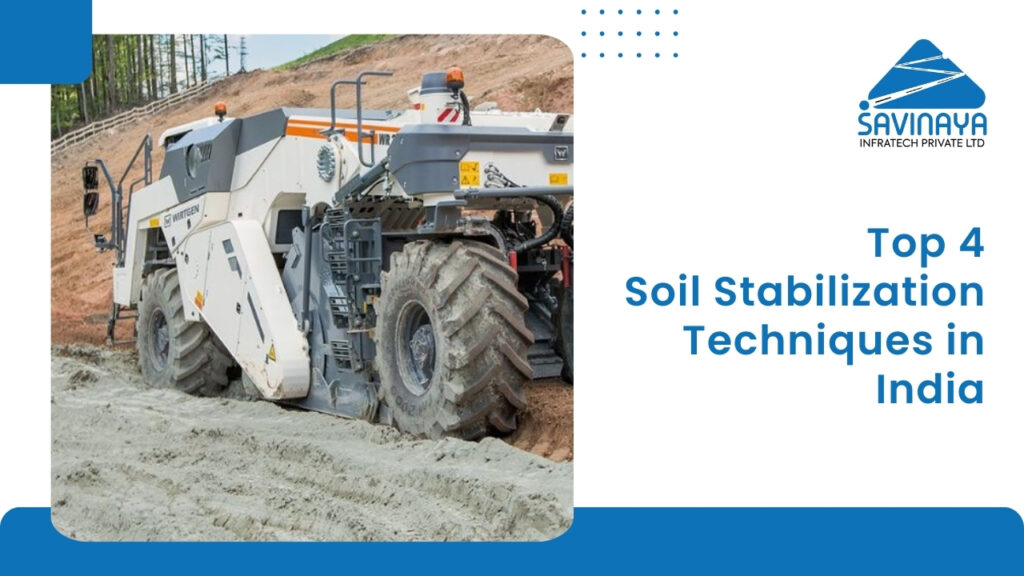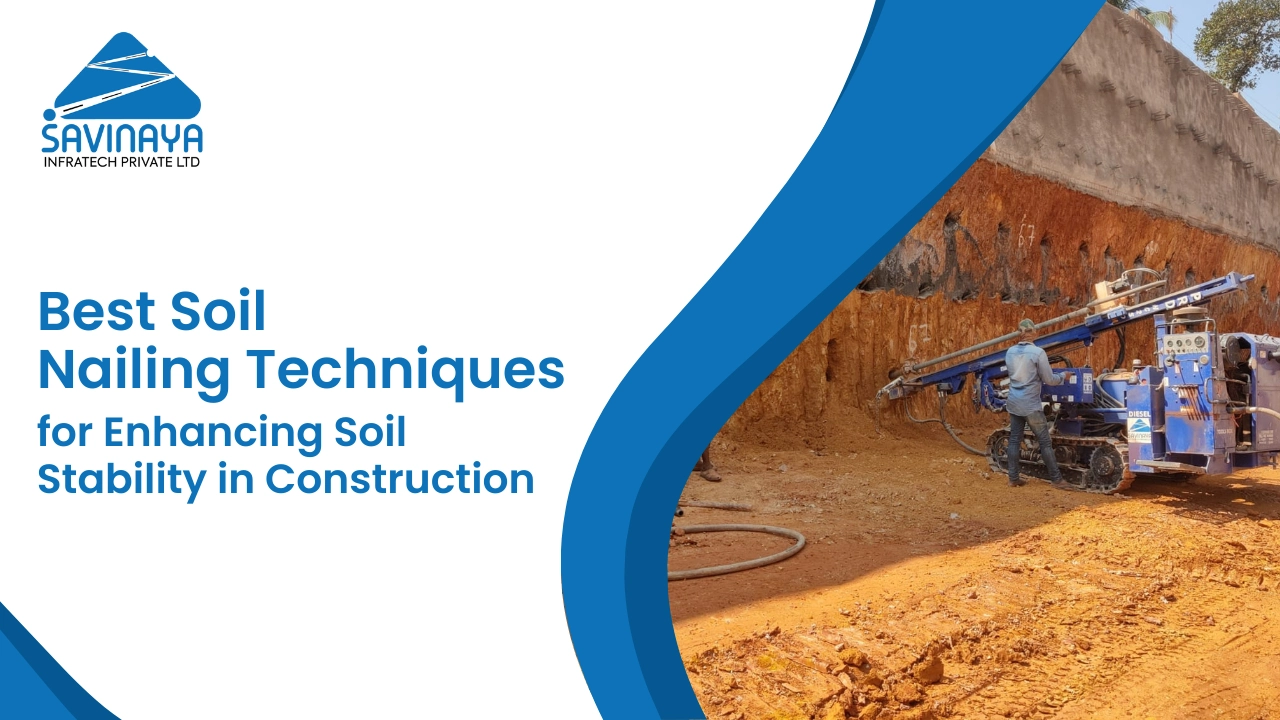Soil stabilisation is the process of altering the physical properties of soil. Soil Stabilization methods are used to improve the soil’s strength, durability, and load-bearing capacity. They help in increasing the mechanical feature of the soil, making it more stable and suitable for building. Stabilized Soil is commonly used in construction and civil engineering to prepare the ground for building projects, roadways, and other structures.
At Savinaya Infratech, we employ various soil stabilization techniques for stabilising soil, including mechanical methods like compaction or densification and chemicals, cementitious materials, or other binders to the soil. In addition, our soil stabilization experts are adept at deciding which soil stabilisation methods to use and putting them into practice based on project specifications and site-specific factors.
Let’s explore the most reliable methods of soil stabilization.
Table of Contents
What Are The Techniques Of Soil Stabilisation?
Soil stabilisation encompasses a range of techniques to improve soil properties for construction. These techniques include both chemical and mechanical methods. Here are some of the techniques that help with the stabilization of soil.
(i) Proportioning Technique: To achieve the intended result, a suitable mixture of accessible materials and aggregates is compacted after being combined. For instance, adding sand or gravel could increase the stability of fine-grained soil and vice versa.
(ii) Cementing Agent: Soil stabilisation by cement is done to strengthen the soil strength. There are some cementing agents like Portland cement, lime, or lime fly ash that can be added to stabilised soil for good strength. Non-cohesive soils benefit from the binding action that bituminous materials provide.
(iii) Modifying Agent: In this soil stabilization technique a modest amount of a modifier is added to enhance the soil’s qualities, such as swelling and high plasticity, to make it a viable building material. Lime is the most often used modifier when dealing with plastic soils to increase soil stabilization.
(iv) Waterproofing Agent: When water seeps through compacted and stable soil, it weakens and becomes saturated. It uses such materials to determine if water absorption can be stopped by applying a waterproofing compound. Bitumen is the most good agent.
(v) Water Repelling Agent: Resinous compounds such as vinsol resin can serve the same purpose as a waterproofing agent by acting as water repellents or retardants for increasing soil stabilization
(vi) Water-Retaining Agent: When moisture is present, certain non-cohesive soils exhibit enough stability. However, as the soil dries entirely, it could become loose. In these situations, an agent, such as calcium chloride, is employed to retain the essential moisture.

Why Is Soil Stabilization Important?
Enhances Soil Strength and Stability
- Soil stabilization provides a more stable and durable foundation for construction projects.
- Soil stabilisation improves load-bearing capacity, supporting buildings, roads, and infrastructure.
Reduces Erosion Risks
- Soil stabilization techniques also control soil erosion, preserving natural landscapes and habitats.
- Minimizes the environmental impact of construction activities.
Prevents Settling Issues
- Soil stabilization reduces the risk of uneven settling and structural damage.
- Ensures the longevity and reliability of structures.
Cost-Effective Solution
- Soil stabilization methods extend the lifespan of construction projects, reducing the need for frequent repairs and maintenance.
- Lowers overall construction and maintenance costs over time.
Promotes Environmental Sustainability
- Utilizes natural or recycled materials, reducing the ecological footprint.
- Supports sustainable construction practices and eco-friendly growth.
Improves Soil Workability
- Stabilise soil facilitates easier and more efficient construction processes.
- Enhances the handling and performance of soil during building activities.
4 Most Effective Soil Stabilization Techniques
Here are 4 effective soil stabilisation techniques that enhance soil properties for various construction projects:
1. Chemical Stabilization
This soil stabilizing technique involves altering soil properties through chemical additives to improve its strength, constancy, and durability.
- Lime Stabilization – Lime stabilization is a process used to improve the engineering properties of soil. It involves adding lime to soil, which helps to increase pH, reduce plasticity, and enhance load-bearing capacity. Lime reacts with the moisture present to produce a chemical reaction that alters the soil’s physical and chemical properties. This process increases the soil’s strength, stability, and load-bearing capacity, making it more suitable for construction and other engineering applications.
- Cement Stabilization – This soil stabilization technique is used to enhance the properties of soil by mixing it with cement, typically Portland cement. The cement stabilization process involves blending cement with soil to create a mixture that, upon hydration, forms cementitious bonds between soil particles. Cement stabilization is widely used in road construction, embankments, and foundations to improve the load-bearing capacity and reduce the susceptibility to moisture-related issues.
- Fly Ash Stabilization – Fly ash soil stabilisation technique is used to enhance the properties of soil by incorporating fly ash, a by-product of coal combustion in power plants. When mixed with soil, fly ash acts as a pozzolanic material, meaning it reacts with water and calcium hydroxide to form cementitious compounds that improve the soil’s strength, stability, and load-bearing capacity. This soil stabilization method is particularly effective in reducing the plasticity and swelling potential of clayey soils, making them more suitable for construction purposes.
Advantages of Chemical Stabilization
Here are three advantages of chemical stabilization:
- Enhanced Soil Strength and Durability: This soil stabilization method significantly improves the load-bearing capacity and shear strength of soils, making them more durable and capable of supporting structures and pavements.
- Improved Moisture Resistance: Stabilized soils exhibit reduced permeability and increased resistance to water, which helps prevent issues like swelling, shrinkage, and erosion. This is especially beneficial for construction in areas prone to moisture variations.
- Cost-Effective and Sustainable: By utilising locally available soils and industrial by-products like fly ash, chemical stabilisation can reduce the need for importing high-quality fill materials. This soil stabilization technique not only cuts costs but also promotes the recycling of waste materials, contributing to environmental sustainability.
2. Mechanical Stabilization
This soil stabilization technique focuses on physically altering soil structure using compaction and mechanical equipment such as rollers and compactors to increase soil density and reduce voids.
- Compaction
Compaction mechanically increases soil density by reducing air voids between soil particles. It is achieved using heavy machinery such as rollers and compactors. Compaction improves soil strength, stability, and load-bearing capacity by minimising settling and enhancing resistance to distortion under applied loads.
- Use Of Mechanical Equipment (rollers, compactors)
Mechanical equipment like rollers and compactors is essential in the compaction process. Rollers, which can be smooth drum or Padfoot designs, exert pressure on the soil surface to compress it uniformly. They are used extensively in road construction and foundation preparation. Compactors are specialized soil stabiliser machine that apply vibratory or impact forces to achieve deeper compaction in cohesive soils or confined spaces.
Advantages of Mechanical Stabilization
Here are three advantages of mechanical stabilization:
- Increased Soil Strength and Stability: The mechanical soil stabilization method increases the physical properties of soil by mixing it with aggregates or other materials, thereby increasing its load-bearing capacity and overall stability. This makes the soil more suitable for supporting structures and infrastructure projects.
- Immediate Improvement: Unlike chemical stabilization, which may require time for chemical reactions to occur, mechanical soil stabilization provides immediate improvement in soil properties. This can expedite construction processes and reduce project timelines.
- Versatility and Adaptability: Mechanical stabilization is versatile and can be adapted to a wide range of soil types and project requirements. By adjusting the type and proportion of stabilizing materials, engineers can tailor the soil stabilization process to meet specific needs, making it a flexible solution for various construction challenges.
3. Biological Stabilization
Biological stabilisation utilises natural organisms and vegetation to improve soil constancy and prevent erosion. Here is a brief overview of its components:
- Use of Vegetation (grass, shrubs)
Planting vegetation with deep root systems, such as grass and shrubs, helps bind soil particles together. The roots create a network that improves soil structure, reduces surface run-off, and enhances slope stability. Vegetation also contributes to biodiversity and environmental sustainability.
- Microbial Stabilization
This soil stabilisation technique involves using microbial agents or bacteria to enhance soil properties. Microbes can improve soil structure, increase nutrient availability, and promote organic matter decay by stabilising the soil over time with various soil stabilisation techniques. This approach is specially effective in rehabilitating degraded soils and mitigating erosion risks.
Advantages of Biological Stabilization
Here are three advantages of biological stabilization:
- Environmentally Friendly: Biological soil stabilization uses natural processes and organisms, such as plants, bacteria, and fungi, to improve soil stability. This soil stabilization method reduces the reliance on synthetic chemicals and minimises environmental impact, promoting a more sustainable approach to soil stabilization.
- Soil Health Improvement: Biological soil stabilization can increase soil health by increasing organic matter content, promoting microbial activity, and improving soil structure. This leads to better nutrient cycling, increased water retention, and improved soil fertility, which can benefit agricultural productivity and ecosystem health.
- Cost-Effective: Utilizing biological soil stabilization methods, such as planting vegetation or introducing beneficial microbes, can be more cost-effective compared to traditional mechanical or chemical soil stabilization techniques. It often requires fewer resources and maintenance, making it an economically viable option for long-term soil stabilization projects.
4. Soil Nailing
Soil nailing is a ground stabilisation technique used to reinforce and stabilise soil slopes, excavations, or retaining walls. It involves drilling holes into the unstable soil or rock face, inserting steel reinforcing bars (nails), and grouting them into place with a cementitious or resinous material. Soil Nails create a stable composite structure that resists sliding and maintains slope constancy.
Advantages of Soil Nailing
Soil nailing offers several advantages for stabilising slopes, excavations, and retaining walls. This technique is highly flexible, making it suitable for various soil types and geological conditions. It allows for rapid installation, even in confined or difficult-to-access areas, and can be more cost-effective compared to traditional retaining wall methods. Soil nailing also minimises disruption to the surrounding environment and existing structures, ensuring stability without extensive excavation.
By reinforcing soil with steel bars and grout, soil nailing provides a reliable and durable solution for preventing soil movement and ensuring the long-term stability of slopes and excavations.
What Is The Best Way To Stabilize Soil?
The best way to stabilise soil depends on the specific conditions and requirements of a project but typically involves a combination of chemical, mechanical, and biological methods.
Chemical stabilisation, using additives like lime, cement, or fly ash, effectively enhances soil strength and durability. Mechanical soil stabilisation, involving compaction with heavy machinery, increases soil density and load-bearing capacity. Biological stabilisation through planting vegetation with deep root systems can naturally bind soil particles and prevent erosion.
A tailored approach that combines these soil stabilizing techniques is based on soil features and project needs. It is the most effective way to achieve long-term soil constancy and performance. Consulting with geotechnical experts such as Savinaya Infratech will help you select the optimal soil stabilization method for each unique situation.
Interesting Reads
What Is Soil Stabilisation And Why Is It Important
Conclusion
Soil stabilisation ensures the lastingness, safety, and sustainability of construction projects. By enhancing soil strength, reducing erosion risks, and improving load-bearing content, stabilised soil forms a solid foundation for infrastructure that withstands the test of time.
The choice of soil stabilisation technique—whether chemical, mechanical, biological, or a combination thereof—depends on various factors such as soil type, project scope, and environmental circumstance. Each soil stabilisation method offers unique advantages in terms of stability, cost-strength, and environmental impact, making it essential to tailor the approach to specific project needs.
With expertise in a wide range of soil stabilization techniques, including advanced chemical treatments, precise mechanical compaction, and eco-friendly biological methods, Savinaya Infratech ensures your project benefits from the most effective and advanced soil stabilisation practices available. Contact Savinaya Infratech today to discover how our specialized services can elevate your construction endeavours to new heights of constancy and performance.


